Computer Gaming
The computer games industry is constantly evolving, and different games platforms have different programming requirements. There is a distinction, for example, between games that can be played on a personal computer (PC) and those that are designed for a dedicated games console, a handheld gaming device, or an arcade machine of the type found in amusement arcades, public houses and social clubs.
Games designed for (or ported to) the PC platform may perform less well by comparison with similar games designed for a dedicated games platform in that the PC's hardware and operating system are designed to run a very diverse range of software, rather than being specifically designed solely for playing games.
It is also frequently the case that a PC cannot run the most recently released computer games because the video graphics adapter card in the PC does not have a sufficiently high specification to cope with the demands of the game's graphics requirements. Computer games are possibly the most resource-intensive software applications in widespread use.
The concept of electronic gaming has been around for a very long time, and certainly predates the development of the modern personal computer, and even many of its recognisable predecessors. The first simple video game (so called because its screen display consisted of a standard television set) was a game called Corndog developed by inventor Ralph Baer in 1966. By 1968 he had produced a prototype unit that could run a small number of different games, including a table tennis game and a target shooting game.
Due to the relatively limited access to computing facilities, many of the earliest computer games were developed in the United States by computing students, and were run on university mainframe computers (probably without the knowledge or consent of the university). Most of these early efforts are long-forgotten, and any record of them lost in the mists of time.
One of the first computer games for which documentation has survived was a program called Spacewar!, which was developed by a small group at MIT comprising students Martin Graetz and Alan Kotok, and MIT employee Steve Russell. The first version of the program was completed early in 1962, and ran on a Digital Equipment Corporation (DEC) PDP-1 minicomputer normally used to calculate statistics. It was a game for two players in which each player had to manoeuvre a spaceship around a central star in order to try and destroy the opposing player's spaceship.
Many of the early computer games were interactive text-based adventure games, and involved the player entering commands via the keyboard in response to text information generated by the game software. One of the earliest known examples of this type of game was called Adventure, partly inspired by the board game Dungeons and Dragons, and developed for the DEC PDP-11 minicomputer by Will Crowther (a member of the team that originally developed the ARPANET) in 1976.
The first half of the 1970s is considered by some to be both the golden age of video arcade games and the first generation of the modern video game itself. It certainly marked the beginning of a new industry, with the first commercially marketed video games appearing in 1971. The market place for PC and console video games has now developed into a multi-billion dollar entertainment industry that, in terms of its profitability, is second only to the film industry. The world's first coin-operated video game was installed in a student union facility at Stanford University in 1971, and featured a game called The Galaxy Game, loosely based on Spacewar!.

A screenshot of the game Spacewar! (1962)
Later during the same year, Nolan Bushnell and Ted Dabney (who were later to found Atari in 1972) developed another coin-operated version of Spacewar! called Computer Space, which was bought by a company called Nutting Associates. Nutting produced 1,500 units, and although the game was difficult to learn and not a great commercial success, it is noteworthy for being the first commercial, mass-produced video game.
Bushnell and Dabney's new company, Atari, released a video arcade game called PONG in 1972. This game was a table tennis simulation in which two players attempted to manoeuvre an electronic bat into position in order to play an electronic ball back to (and hopefully past) their opponent. Atari developed a console version for home use in 1975. In total, they total sold 19,000 PONG machines, and there was no shortage of imitators.
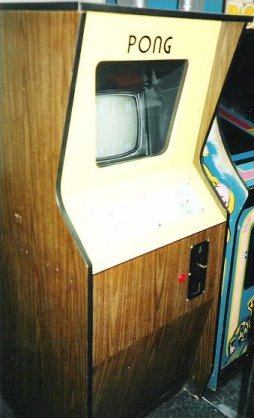
One of the original PONG machines (1972)

A screenshot of the game PONG (1972)
During the early 1970s a small group of manufacturers, including Atari, Magnavox, Fairchild and RCA, launched a number of console-based video games. These early consoles had either one, or a small number of games hard wired into them. The introduction of inter-changeable cartridge-based games was a later development.
Most of these early consoles were designed to work with a standard TV screen, and some involved the use of plastic overlays that were positioned on the screen itself and held in place by static electricity. The market for console games suffered a significant setback in 1977, when manufacturers of older games consoles sold off stock at a loss to clear stocks, creating a glut in the market that drove down profit margins generally. Only Atari and Magnavox continued to manufacture console games.
The zenith of the video arcade game era is thought by some to have occurred in the year 1978, when the game Space Invaders was released and proved to be hugely popular. In fact, the game was so successful that it inspired a number of manufacturers to enter the market. Other releases of note included Asteroids (released by Atari in 1979) and Pac-Man, developed by Namco and first released in 1980. Video arcade game machines proliferated in amusement arcades and other public venues.
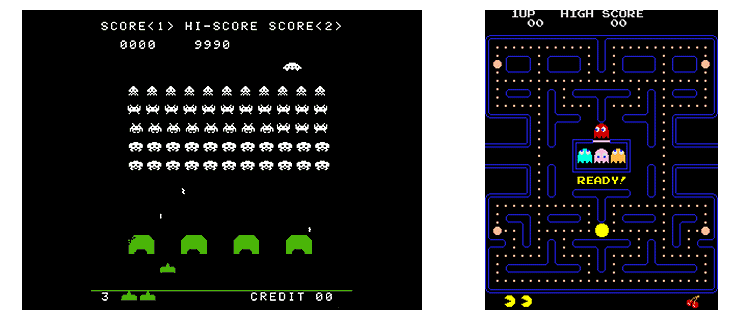
The highly popular arcade games Space Invaders (1979) and Pac-Man (1980)
Video games first appeared in cartridge format in 1976 with Fairchild's Video Entertainment System (VES), and consisted of ROM chips encased inside a plastic cartridge that could be plugged into a slot on the console. Gamers could now collect a whole library of games for their chosen games console. Atari released its first cartridge-based console, the Video Computer System (VCS) in 1977. They later renamed it to the Atari 2600, and it became the most popular of the early console systems.
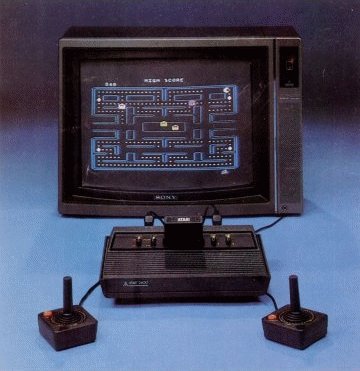
The Atari 2600 games console
By the early 1980s, personal computers had become powerful enough to run games such as Adventure, but there was already a move away from purely text-based games towards games that involved both text and simple graphics. Such games had been developed and distributed (in the form of program source code) from the mid-seventies onwards, through special interest groups and gaming magazines. The code could be entered directly into a computer via a keypad, and would then run in interpreted mode, allowing the user to play the game.
One of the first such games to be sold commercially was called Microchess, which appeared in 1977 and sold more than fifty thousand copies. While the market for arcade game equipment and dedicated video game consoles declined during the early eighties (culminating in a virtual market crash in 1983), the popularity of the personal computer as a gaming platform was boosted by the availability of affordable home computers with a basic colour graphics capability, such as the Commodore 64, which first appeared in 1982.
This computer, like many of its contemporaries, consisted of a single unit with a built-in keyboard and was used in conjunction with a standard TV screen. Programs were stored on standard audio cassette tapes and loaded via a separate audio-cassette player. The Commodore 64 was aggressively priced, had a built-in BASIC programming environment, and was to become the single best-selling computer model of all time.
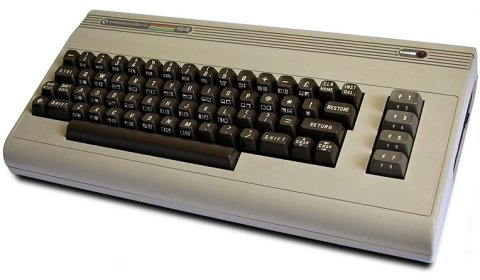
The Commodore 64 home computer
In the USA, the most popular gaming computers of the 1980s were the Commodore 64 and the Apple II (which was already fairly well established by that time). These computers were also popular for gaming in the United Kingdom, although the Sinclair ZX Spectrum took a significant market share here and in Europe, while the Atari 800 held a similar place in the US market.
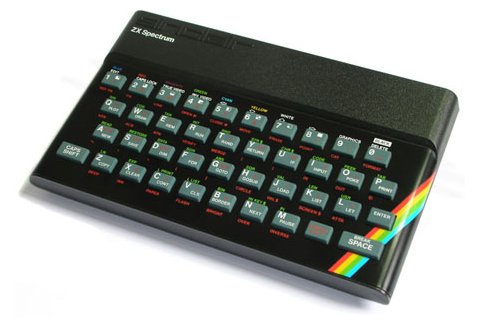
The Sinclair ZX Spectrum
The King's Quest adventure game released by Sierra in 1984 featured colour graphics and a third-person perspective. An on-screen character could be moved behind or in front of objects drawn on a 2D background, creating the illusion of a 3D environment, although the game was still controlled via the keyboard using text commands. The game Maniac Mansion, released in 1987 by LucasArts, abandoned the text-based command for a mouse-driven point-and-click interface. Other games companies were quick to follow suit.
The game Elite, originally released in 1984 for the BBC Micro and Acorn Electron computers, introduced 3D graphics and was soon ported to other popular computer platforms, including the Commodore 64 and Amiga, the Sinclair ZX Spectrum, the Atari ST and even the Nintendo Entertainment System (NES).
Also in 1984, the IBM PC/AT with its 16-colour EGA display was at last in a position to compete with other home computers as a games platform, although its sound capabilities were still limited to using the built-in speaker and it was still expensive by comparison with its contemporaries.
The Atari ST and Commodore Amiga which appeared in 1985 were among the first 16-bit computers, although they were beyond the reach of many gamers due to their price.The VGA graphics standard that emerged in 1987 was developed for the IBM PS/2 family of 8-bit computers, and gave them the potential for 256-colour graphics. This encouraged a boom in the development of games for the 8-bit IBM PC, despite the technical superiority of the Amiga and Atari ST computers for gaming.
Towards the end of the 1980s, dedicated sound cards began to appear for the IBM PC, significantly improving its audio features. The popular AdLib sound card emerged in 1987, and was closely followed by the SoundBlaster sound card from Creative Labs in 1989, which maintained compatibility with the AdLib cards but added new features, becoming the new de facto audio standard.
A new form of gaming emerged during the 1980s - that of online gaming. Bulletin board systems, which allowed users to log into to Internet computers and post information, or access information posted there by other users, were sometimes also used for playing online games over a dial-up connection.
The gaming interface was generally quite crude, and consisted of either a text interface or a simple graphical interface generated using IBM graphical character codes. In some cases, games could be played by a number of participants. The most popular of these early multiplayer games were fantasy role-playing games known as multi-user dungeons (MUDs). Such games were essentially the fore-runners of today's massively multiplayer online role-playing games (MMORPGs).
1980 also saw the emergence of the handheld games console, notably Nintendo's Game & Watch products, which had liquid crystal displays (LCDs) and often ran on watch batteries. For a number of reasons, the market for video games crashed in 1983, precipitating the bankruptcy of a number of producers of home computer and game consoles, and bringing the second generation of video gaming to an end.
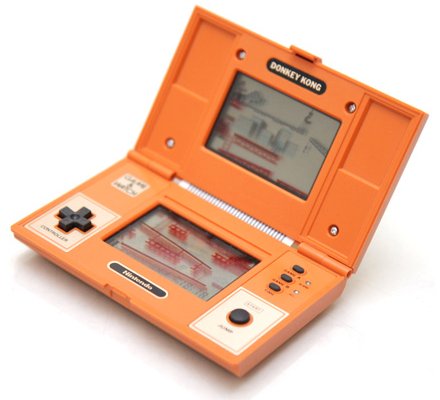
A Nintendo Game and Watch handheld, featuring Donkey Kong
Following the collapse in the market for console-based games, computer gaming came of age. Computers had now attained more or less equal status with consoles in terms of their game-playing capabilities, and for gaming purposes at least were almost as easy to use as consoles. By the early 1990s, increasingly powerful processors enabled computers to display 3D graphics and sophisticated multimedia content, while the development of sound cards and CD-ROM technology further extended the gaming potential of the IBM personal computer.
Early 3D games first used flat-shaded graphics, and later simple texture mapping (e.g. ID Software's Wolfenstein 3D, released in 1992). Meanwhile, the console market experienced a revival in 1985 with the release of the highly successful Nintendo Entertainment System (NES), which came complete with Super Mario Brothers. The NES dominated the US and Asian markets until the early nineties, although in Europe it faced competition from other products, such as the Sega Master System. The Sega Mega Drive made its debut in 1989 and was also highly successful.
The default game controller for the NES was the gamepad, which largely supplanted the use of joysticks, paddles and keypads. The gamepad had eight directional buttons, and two or more action buttons. Handheld console systems were brought to the fore in 1989 by the released of the Nintendo Game Boy, which came with the game Tetris, and subsequently dominated the market for handheld consoles.
During the 1990s, a number of games software developers emerged, including Apogee, Epic Megagames and ID Software. Their marketing strategy included the distribution of demo versions of their games as shareware. The idea was to get users to try out the demo version of a game (usually one complete level of the game) and get them sufficiently interested to buy the full version. These demo versions were often distributed on floppy disks with gaming magazines, or via the Internet.
Later, as the size of the software packages increased, the use of floppy disks became impractical and they were replaced by CD-ROM discs. The popularity of arcade games had been declining, partly due to the fact that many gamers would simply wait for popular arcade games to be ported to consoles or the PC rather than go out and part with cash in an arcade.
There was a brief resurgence in the popularity of arcade games during the early-to-mid 1990s with the release of games like Street Fighter II (published by Capcom and released in 1991) and Mortal Kombat (created by Ed Boon and John Tobias in 1992). Like many of its contemporaries, Mortal Kombat was subsequently ported to other platforms such as the Super Nintendo Entertainment System (SNES), Nintendo's new generation of game consoles released in 1991.
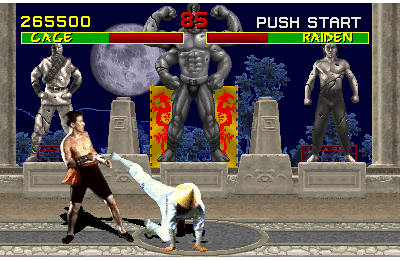
A screenshot from the Mortal Kombat arcade game
1992 saw the release of Dune II by Westwood Studios, a real-time strategy (RTS) game. Whilst far from being the first game in the genre, it set standards for game mechanics that were adopted by later RTS games such as Command & Conquer. The game Alone in the Dark was released by Infogrames in the same year, and although once again it was not the first of its kind, it made a similar contribution to the survival-horror genre of games, establishing features later seen in games such as Resident Evil and Silent Hill.
In 1993, a game widely regarded as one of the most important titles in gaming history, Doom, was released by ID Software. Adventure games released during this period included The Secret of Monkey Island (released in 1990 by LucasArts) and Myst (released in 1993 and developed by Cyan Worlds). The popularity of adventure games was waning, however, with the rise of real-time action-based games.
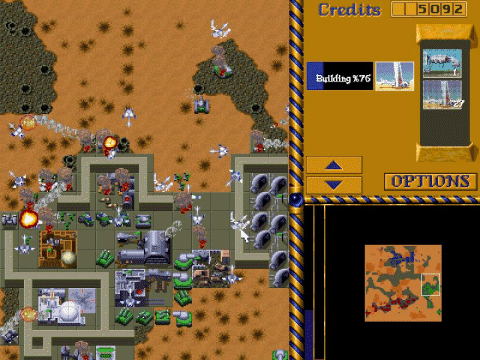
Dune II screenshot
During the 1990s, Maxis published a number of highly successful simulation (Sim) games, beginning with SimCity and including The Sims, one of the best-selling PC games of all time, in 2000.
1996 saw the introduction of the 3dfx Interactive Voodoo chipset that enabled the production of affordable 3D accelerator graphics cards for personal computers. These cards were able to undertake some of the processing required for rendering complex 3D graphic images, removing much of the burden from the CPU which was then free to handle the game logic.
Among the first games to take advantage of this new technology were first-person shooter (FPS) games like ID Software's Quake, released in 1996. Tomb Raider, which was released in 1996 by Eidos Interactive, was one of the first third person shooter (TPS) games and was noteworthy for its revolutionary graphics (among other things). The performance of FPS and TPS games became both the technology driver for the development of 3D hardware and the yardstick by which its performance was measured.
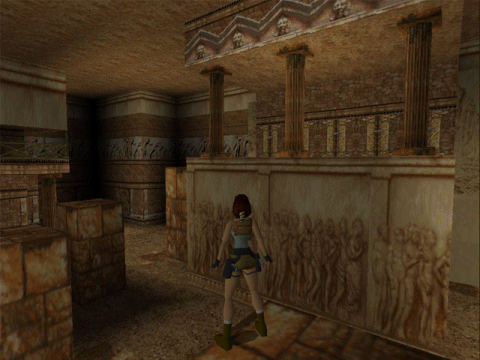
Screenshot from an early version of Tomb Raider
Quake was noteworthy for being instrumental in pioneering Internet multi-player gaming for the first-person shooter genre, and essentially established Internet multi-player capability as a de facto requirement for FPS games. Other genres also began to offer online play, including real-time strategy games such as Age of Empires published by Microsoft Game Studios and released in 1997.
The 1990s also saw the emergence of browser plug-ins like Java and Flash that enabled simple browser-based games to be written. In fact some of the classic arcade games, such as PONG, Space Invaders and Pac-Man have been re-written as browser-based versions of the original games that are virtually identical in terms of their look, feel and game play to the originals.
Since the advent of first-person shooter and real-time strategy games, perhaps the only significant new game genre is the third-person shooter, which includes games such as Grand Theft Auto III (Published by Rockstar Games and originally released in 2001 for the PlayStation 2), Tom Clancy's Splinter Cell (Published by Ubisoft and released in 2002), and the Hitman series of games (Hitman: Codename 47 was published by Eidos Interactive and released in 2000).
Multiplayer gaming has been increasingly supported by console platforms, with two or four controller inputs being included as standard, with the option to expand the number of input devices using additional adapters. While personal computers such as the Atari and Commodore systems featured at least two game ports, IBM PCs were usually limited to one game port, or even no game port at all.
Internet gaming on the early computers was restricted to text-based MUDs, due to the slow speed of dial-up connections and the relatively high cost of Internet access. The emergence of local area networking technologies made multiplayer gaming possible, and set the scene for the later emergence of multiplayer online gaming when Internet connectivity became both faster and more affordable.
In recent years, fast and affordable broadband Internet services have been a major factor in the rise in popularity of online multiplayer gaming. The new millennium has seen the rise of Massively Multiplayer Online Role-Playing Games (MMORPGs) such as World of Warcraft from Blizzard Entertainment, which first appeared in Europe in 2005.
Mobile gaming jumped from the handheld console to the mobile phone in 1998, when Nokia included the Snake game with its new line of mobile phones. Most other vendors of mobile phones have since followed suit. The early mobile phone games were restricted by the relatively small monochrome displays available, the limited amount of memory and processing power, and the fact that their use tended to drain the battery rather quickly.
Since that time, colour displays and improved memory and processing power have greatly enhanced the mobile phone gaming experience, and by 2007 mobile phone games software was generating an estimated twenty-five percent of all video game software revenue. Notable players currently are Nokia with their Smartphone range, and Apple with the iPhone.

Gameplay on the Apple iPhone
On the console front, 1995 saw the release of the PlayStation by Sony which, together with the Super Nintendo Entertainment System, subsequently enjoyed a dominant position in the console market. The Nintendo 64 was released in 1996 together with the 3D Super Mario 64. Their decision to use cartridges rather than the (relatively) new CD-ROM format, however, proved to be a mistake.
Although the performance of cartridge-based games was generally better, CD-ROM discs could hold considerably more data and were cheaper to produce. As a result, software vendors like Squaresoft, who had produced all of its versions of Final Fantasy to date for Nintendo, instead wrote Final Fantasy VII (released in 1997) for the PlayStation. The game was a huge success, boosting the popularity of role playing games and at the same time establishing the PlayStation as the dominant console platform and Sony as the market leader.
The popularity of Microsoft Windows and the increasing affordability of IBM PCs encouraged efforts to port 3D console titles like Super Mario 64 to the PC platform, and drove the development of affordable hardware accelerated 3D graphics adapters for the PC. The result was the emergence of powerful new graphics cards such as the ATI Rage, Matrox Mystique, and Silicon Graphics' ViRGE, together with the maturation of 3D graphics technologies such as DirectX and OpenGL.
Graphics card manufacturers, notably ATI and NVidia, have continued to improve the capabilities of their products, allowing game developers to create increasingly sophisticated and realistic 3D games. On the down side, many older MS-DOS-based games could not be played on a Windows-based PC without the use of emulation software such as DOSbox. Other technological developments include the emergence of physics engines for computer games, although the relative merits of this technology in terms of improving game play have yet to be established.
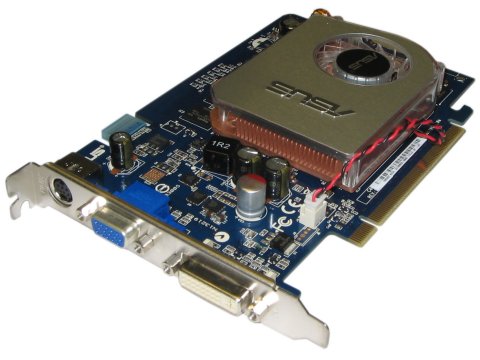
A 512Mb ASUS EN8500GT Magic with nVidia GeForce 8500 GT chipset
As well as the improvements in graphics processing, computer hardware manufacturers have been continually improving the performance of the central processing unit, both by increasing the size of the processor's internal registers and augmenting the instruction set, and by increasing clock speeds to allow more instructions to be executed per second. A common measure of processor performance is millions of instructions per second (MIPS).
Other improvements in CPU performance have been achieved through the use of pipelining (carrying out multiple execution cycles in parallel), the increased capacity of internal memory caches, and the availability of fast, high-capacity internal memory (RAM) modules.
Since 2005, the emphasis has moved away from increasing processor speed (which is beginning to be affected by the law of diminishing returns) and towards multi-core CPUs that effectively harness two or more processors to carry out the simultaneous execution of multiple program threads. Meanwhile the range of peripherals available for the PC for gaming has grown to include many of those commonly available for game consoles, including joysticks, gamepads, and steering wheels.
The console market has also continued to evolve. Sega made a last throw of the dice when they introduced the Dreamcast in 1998, but failed to capture a significant market share. Sega formally withdrew from the console market in January 2001. Sony introduced the PlayStation 2 in Europe late in 2000, and as of the start of 2009 had sold 136 million units. The best-selling game for the PlayStation 2 to date is Grand Theft Auto: San Andreas, with sales of over 17 million copies.
Nintendo's GameCube was released in Europe in 2002, and was their first disc-based console. The GameCube was technically on a par with PlayStation 2, but suffered from having less third-party games available for it than the Sony console, and never achieved the same popularity.
Microsoft, meanwhile, seeing a gap in the market left by the departure of Sega and declining fortunes of Nintendo, chose 2001 to enter the console market with the Xbox, based on Intel's Pentium III processor. Later that same year, Bungie Studio released Halo: Combat Evolved for the Xbox, ensuring the success of the Xbox and becoming one of the most successful first-person shooter games of all time (the Halo series of titles have since been ported to Microsoft Windows and Mac OS X).
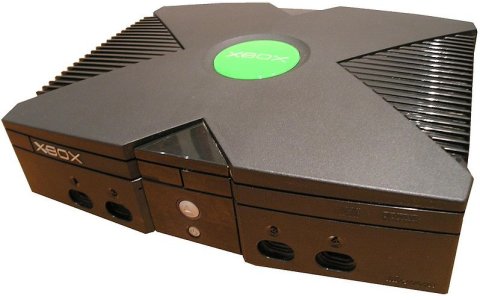
Microsoft's Xbox
During the last decade, Nintendo have maintained a strong position in the handheld market, releasing their Game Boy Color in 1998, and the Game Boy Advance in 2001. In 2004, Nintendo and Sony introduced their next-generation handheld products within a month of each other, Nintendo with the Nintendo DS, and Sony with the PlayStation Portable (PSP).
Rather than trying to compete with Sony's product in terms of graphics capability and power, Nintendo gambled on a design that was less sophisticated but featured two screens, one of which was touch-sensitive. The Nintendo offering proved to be hugely popular with consumers, and allowed Nintendo to continue their dominance of the handheld market. Nintendo followed up with the DS Lite in 2006, and the DSi in 2009. Sony meanwhile introduced an updated version of the PSP in 2007.
Contemporary developments in the console market saw Microsoft introduce the Xbox 360 in 2005, while Sony released the PlayStation 3 in Europe in 2007. Both products offer high-definition graphics, disk-based secondary storage, integrated networking, and on-line gameplay in the form of Xbox Live and the PlayStation Network respectively.
Nintendo introduced the Revolution console (later renamed Wii) in 2006. The Wii had a new control paradigm that featured motion-based control and infrared-based pointing, and during the next eighteen months became one of the world's fastest selling game consoles.
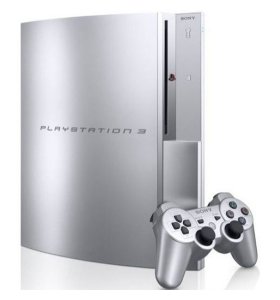
The Sony PlayStation 3
